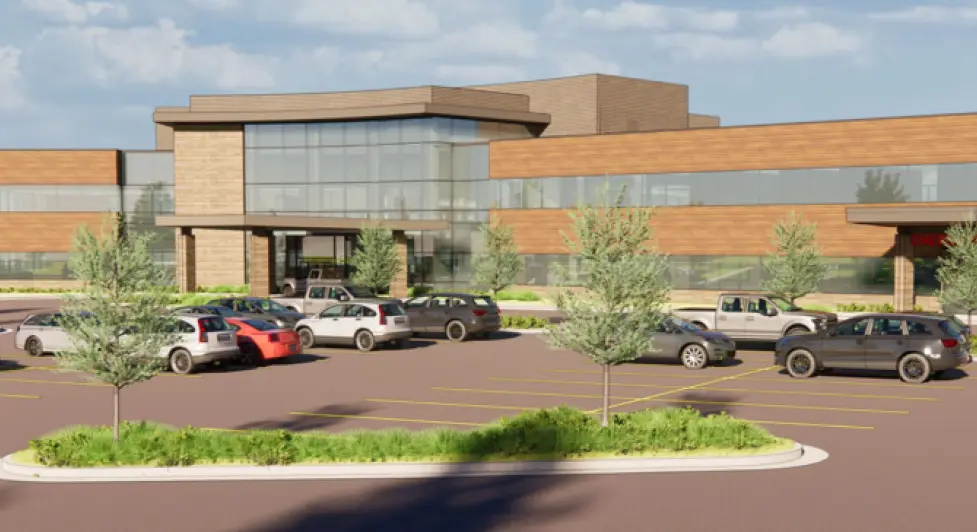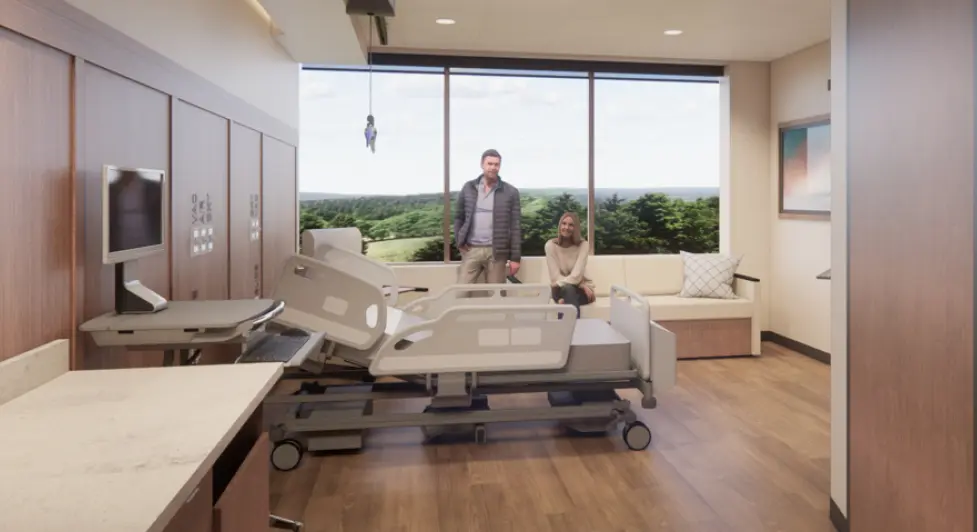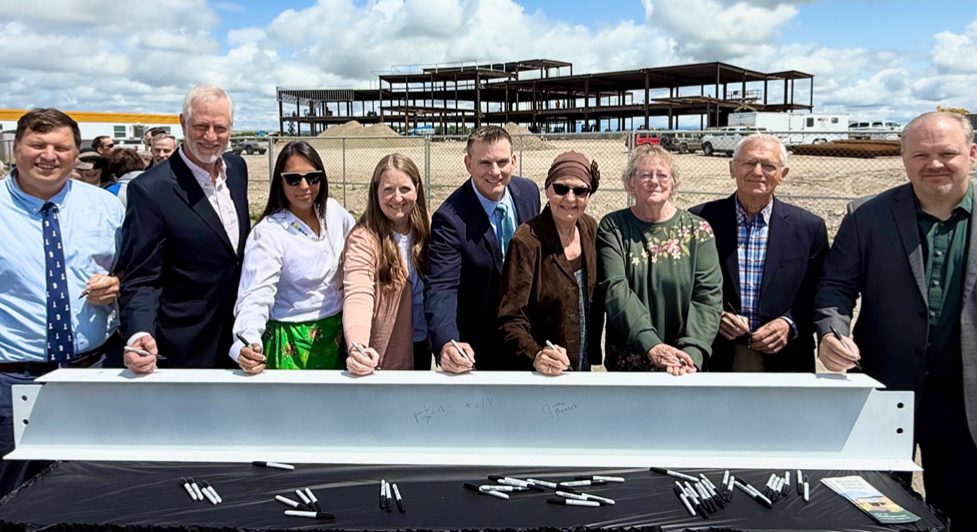How Lument and Community Leaders Revived Rural Healthcare in Riverton, Wyoming
Hospital | Riverton, Wyoming
A USDA-backed loan is powering construction of a modern rural hospital expected to create jobs and revitalize local healthcare.
On the home page of Riverton Medical District’s website, there is a quote from cultural anthropologist Margaret Mead: “Never doubt that a small group of thoughtful, committed citizens can change the world; indeed, it’s the only thing that ever has.”
When the hospital in Riverton, Wyoming, began shedding services, concerned citizens banded together in an effort that would put Mead’s quote to the test. Could a team of dedicated community members restore healthcare services to the city by building a new hospital? In the case of the working group including locals Vivian Watkins and Corte McGuffey, the answer turned out to be a resounding yes.
The group began with community stakeholders but soon grew to include rural healthcare experts Stroudwater Associates, Montana’s largest independent healthcare system Billings Clinic, the Eastern Shoshone Tribe, the U.S. Department of Agriculture (USDA), and Lument, a leading healthcare lender with USDA financing experience.
It began in 2018, when several community members met in a coffee shop to discuss whether there was any way they could convince their existing hospital to stop cutting services. Following over seven years of challenges, setbacks, and financial hurdle after hurdle, those efforts culminated with shovels hitting the ground in December 2024, as construction began on the brand-new Riverton Medical District.
A group of concerned citizens did indeed change the world, leading the creation of a state-of-the-art facility that will restore essential healthcare services to 22,000 neighbors and is expected to generate approximately 140 new jobs and more than $25 million of yearly economic activity—thereby making the city of Riverton a more attractive place to live for longtime residents and newcomers.

Background
When Riverton’s hospital first began removing services and transferring them to a nearby town over a decade ago, community members were told there was no reason to be concerned. As time went on, however, the impact became undeniable. Services were cut, doctors were let go, and patients were sent to other hospitals for routine surgeries. As negative experiences piled up, more conversations took place within the community, with everyone asking the same question: what can we do?
Vivian Watkins, former director of economic and community development for the state of Wyoming and a neighbor to many, knew that the community had options, although none would be easy.
“There are lots of things you can do if you have the nerve and the backbone and the time,” she said. “So, a few of us decided to see if there was a network of folks that were concerned enough to dedicate themselves to this.”
Little did that initial group know that their dedication, as well as their resolve, would be tested time and time again over the next several years. But, as Watkins said: “When you take this on—as long as you are positive that you have the community behind you—then you just take one step at a time, and you never give up.”
Initially, it was a “save the Riverton hospital movement,” McGuffey, an owner of two local businesses and a championship-winning quarterback in the late 1990s at Division II’s University of Northern Colorado, pointed out. “We reached out to hospital leadership and communicated how important those services were to the community, asking if there was anything we could do to help bring them back. Those letters fell on deaf ears,” he added.
After exhausting all options, including regular meetings with hospital leadership, the answer became clear. Confirmation came when the local senator called and said that they should cease their efforts.
“If they won’t work with us, then let’s build our own damn hospital,” Watkins said to the other group members. “After everyone’s jaws dropped and we took a couple seconds, they all said, ‘yes, let’s do it.’”
The next step was to investigate whether such a venture could be successful, and if so, what it would look like. The group spoke with experts at local hospitals in Douglas and Cody, Wyoming, receiving help and insights from their boards and CEOs.
It was recommended that they contact Stroudwater Associates, a healthcare consultancy specializing in rural areas, to conduct a feasibility study, which came with a meaningful price for a town the size of Riverton.
“We went to the community and said, ‘this is the first step, we need to find out if we’re crazy or if this will work. Everyone get their checkbooks out and let’s see what we can come up with,’” Watkins said. “Within three months, we had raised the funds needed.” The money came from donations of all sizes, from large checks to five-dollar bills.
Stroudwater was well-versed in the situation Riverton found itself in and understood the impact such closures have on a community. Its report came to a clear conclusion: Riverton could support a fully functional hospital, as it had for decades before the consolidations and cuts began.
“Stroudwater gave us a lot of confidence to move forward,” McGuffey said.
Challenge
With the validity of their venture in hand, the group turned to the next step: finding financing.
“At first, it was how are we going to get $45 million for development,” McGuffey said. “Of course, that eventually turned into nearly $70 million.”
The group first considered bond financing, as the nearby hospital in Douglas had done successfully. However, as a group of volunteers doing their own project, they couldn’t secure a bond rating, so that option was quickly eliminated.
“We met with the state business council, we met with everyone we could think of,” Watkins said. “But we are a 501(c)(3) nonprofit, and you must be a governmental entity to qualify for a lot of this funding, which we are not. Also, even if we could qualify, these were typically $1 or $2 million loans, not nearly enough.”
In its report, Stroudwater mentioned the USDA Community Facilities (CF) program, a permanent debt funding option with the primary purpose of improving rural communities. At first glance, the program was a great fit. However, to apply for USDA CF funding, an examination opinion is needed, which includes a section on existing financials, something the group of volunteers did not have.

Meanwhile, the group worked on deciding upon a location for the facility. They found an ideal spot in town that was owned by the Eastern Shoshone Tribe. The tribe had been looking for a project for this deeded land and found one in Riverton Medical District, as they agreed not only to sell the plot but also donate a portion to help generate equity.
As the group continued to look for funding, the Shoshone tribe’s developer, Steve Wilson, recommended they contact Lument’s Rob McAdams in Denver, whom Wilson knew had experience closing USDA CF loans.
Solution
McGuffey and McAdams met in February 2020 and discussed the scenario. Despite the fact that there was no precedent for an independent group leading such a venture, the story was so compelling that McAdams was able to obtain three different proposals for an examination opinion.
“Since we were not able to attest to existing financials, which did not exist, we were able to attest to proforma and lean on the Stroudwater report, as well as the fact that the city supported a hospital for many decades,” McAdams said.
The community raised more money to cover the costs of the examination opinion, which was successfully completed, and then the USDA CF application was submitted.
Knowing that a major factor for USDA consideration is community support, the group leaned on their fellow citizens once again, as approximately 270 citizens wrote letters to USDA detailing their often-traumatic health experiences since the cutbacks began. From medical associations to doctors at nearby hospitals, the group had no shortage of credible information and heartfelt anecdotes that demonstrated the need for restored healthcare services to the people of Riverton.
Also helping the case with USDA was the working group’s selecting Billings Clinic, an award-winning operator and management company, to manage the hospital once complete.
“Billings had a model we fell in love with, as we are both adamant that healthcare is best done locally,” McGuffey said. “Their backing us gave USDA confidence in the project.”
Finally, after years of effort, USDA was officially on board, and the CF loan was approved for $37 million, as well as a $1 million grant. That was a good day for everyone.
“That was one of the best days, when USDA called us and told us our loan was approved,” said McGuffey. “It was an awesome feeling. We had been working so hard.”
In its approval, USDA made it clear that community support was a key factor. At one point in the report, the author strayed from application-speak and made a rare first-person statement: “The applicant started a true grassroots movement to bring back essential services to the community and has exhibited a level of community support, both monetarily and otherwise, that is unseen in my experience.”
The arranging of funding was not complete, however, as a $23 million gap remained.
“We started out thinking we would need 10% equity to complete the capital stack,” McGuffey said. “We ended up with a third of the project in equity from state and community funds.”
A portion of those funds came from a half-cent economic development tax the group got on the ballot in 2020, after obtaining thousands of signatures during the height of COVID. The tax passed by 50 votes. (What McGuffey called a landslide).
“Taxes don’t pass here,” McGuffey added bluntly. Nonetheless, once again, the community was behind the project, and the result was another $1.4 million for development.
Perhaps most importantly, they were able to secure an additional $15 million of American Rescue Plan Act (ARPA) funds from the state for the project. But it didn’t come easy. The board worked hard to carve out some of the state’s allocated $1 billion in ARPA funds and had to meet a strict deadline, as they would lose the funds if the project was not under contract by the end of 2024.
“We used every day allowed to us,” McGuffey noted, as the project went under contract and all the funding was in place with only a few days in December remaining.
Impact
With development at Riverton Medical District well underway, the group has no time to linger on the challenges of the past. However, the recent ground-breaking ceremony did provide a moment of reflection on how far they had come and how much they had already achieved.
“The ceremony was all about creating a future for Riverton, creating a place where retirees feel comfortable living here,” McGuffey said. “There are a lot of people that love Wyoming, love the rural lifestyle, but they move away because they didn’t feel secure with medical care. We want retirees to stay, and we want young people to see a future here.”

Construction is expected to be complete in September 2026, with a grand opening soon after. The new hospital will feature 24/7 surgery, emergency care, inpatient intensive care, lab, radiology, and pharmacy services, and a primary care wing staffed with local doctors. In addition, families will once again welcome their children into the world in Riverton, something that hasn’t been possible for several years since deliveries were moved out of town.
“It makes my heart happy to see the construction underway,” Watkins said. “And the thing I am most proud of is the fact that most of the people who walked out of that coffee shop with me eight years ago are still next to me as we sit around our table with our board every month, discussing the future of Riverton Medical District,” Watkins said.
This working group proved that not only can concerned citizens change their community, but they can also vastly improve it and overcome a series of challenges on the way. From obtaining USDA funding with an unprecedented story to meeting an ARPA deadline by days, nothing could stop this group from restoring healthcare services to their community.
“Even with all the challenges, I never questioned that Vivian and Corte were going to succeed and make it happen,” McAdams said. “Without a doubt, this is the deal I am most proud to have played a small part in throughout my entire career. No other deal will have as big of an impact.”